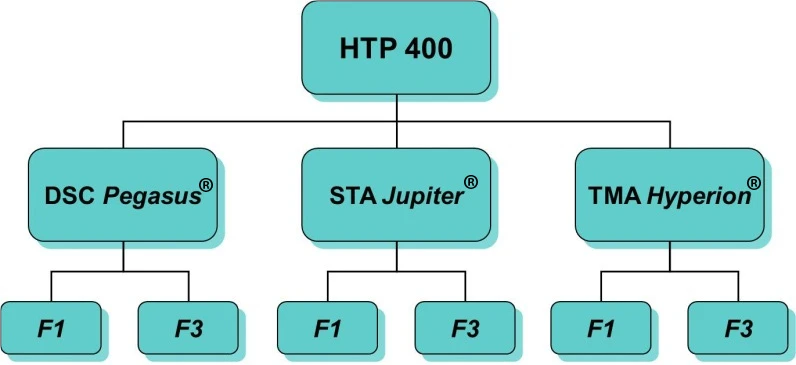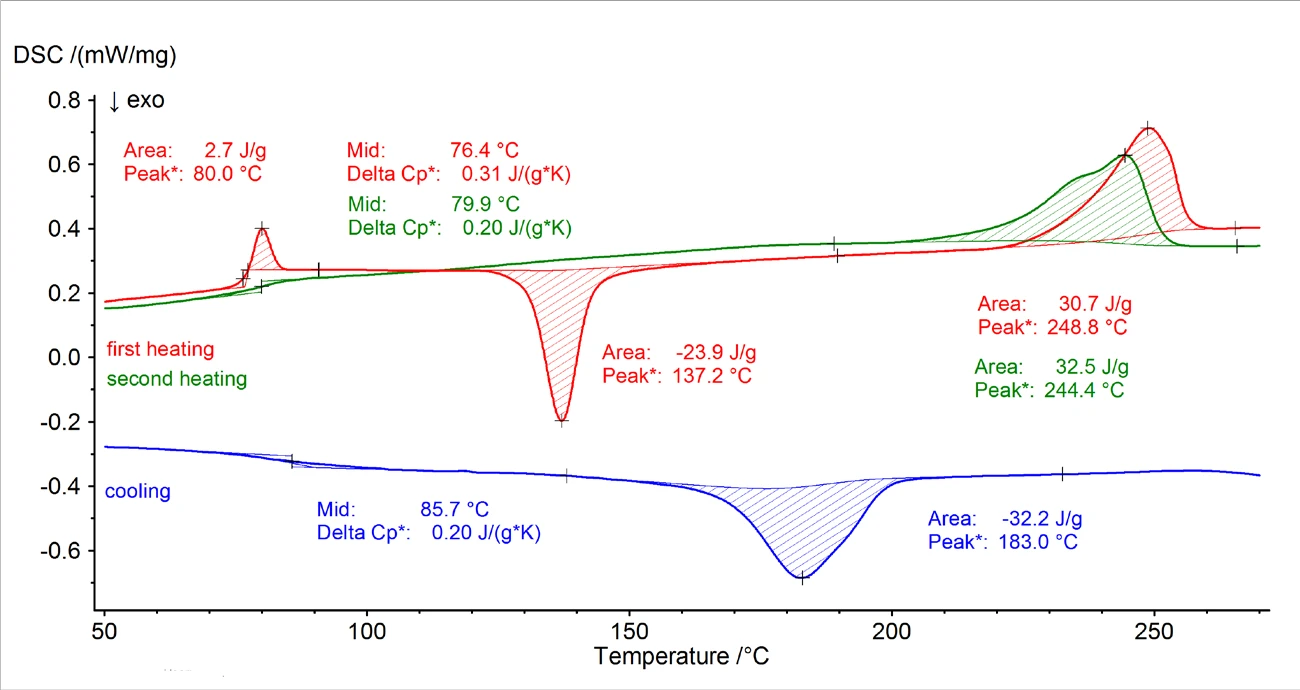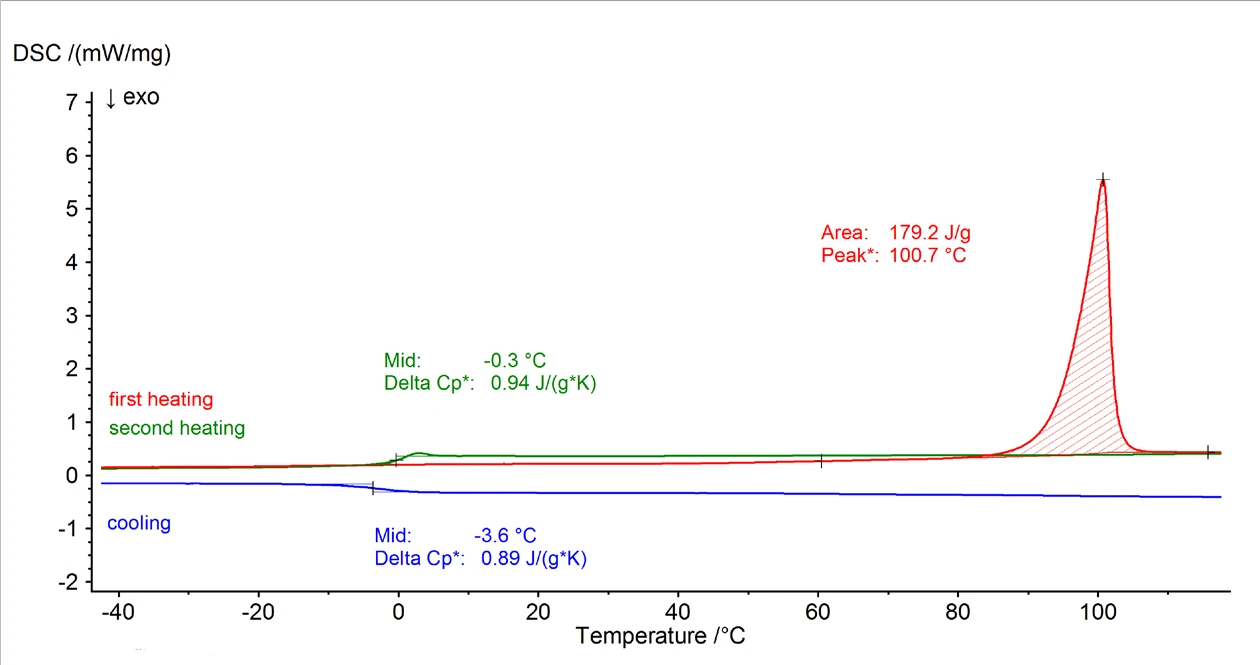Introdução
O conceito de plataforma da NETZSCH-Gerätebau GmbH
Atualmente, nosso conceito de plataforma é composto por três instrumentos básicos (DSC, STA e TMA), cada um dos quais vem em dois modelos diferentes (F1 e F3 ). Todos os componentes eletrônicos necessários para a operação desses instrumentos, juntamente com a unidade de fornecimento de gás, estão contidos em um único compartimento integrado. Os fornos e os suportes de amostras podem ser trocados de forma rápida e fácil pelo operador. Essa configuração modular não apenas confere uma aparência uniforme aos instrumentos, mas também permite flexibilidade máxima para se ajustar a situações analíticas em constante mudança e para facilitar a implementação de quaisquer modificações necessárias nas condições de operação do instrumento. A Figura 1 mostra as várias versões de instrumentos que compõem o conceito da plataforma.
Um forno de aço está disponível para todos os três tipos de instrumentos. Isso permite a cobertura de uma faixa de temperatura de -150°C a 1000°C na amostra. Esta nota de aplicação discutirá os resultados de medição típicos dessa faixa de temperatura para polímeros (termoplásticos, elastômeros) e substâncias orgânicas cristalinas, como o açúcar.

STA 449 F1 Jupiter® com forno de aço
Além das variações de instrumentos mencionadas acima, é possível fornecer diversos complementos para a análise térmica simultânea (STA), como métodos de acoplamento, PulseTA® ou o gerador de vapor de água. Atualmente, há nove sistemas de fornos disponíveis para o STA 449, cobrindo uma faixa de temperatura de -150°C a 2400°C na amostra (figura 2).

Condições de medição
Os resultados da medição de um filme de polímero feito de polietileno terftalato (PET), duas amostras de elastômero e sorbitol - um açúcar C6 - são apresentados nesta nota de aplicação. As condições padrão foram empregadas em todas as investigações; elas estão resumidas na tabela 1.
Tabela 1: Condições de medição
| Elastômero | PET | Sorbitol | |
|---|---|---|---|
| Instrumento de medição | STA 449 F3 Jupiter® | STA 449 F3 Jupiter® | STA 449 F3 Jupiter® |
| Tipo de forno | Forno de aço | Forno de aço | Forno de aço |
| Suporte de amostras | Octogonal (ASC) | Octogonal (ASC) | Octogonal (ASC) |
| Termopar | P | P | P |
| Controle de temperatura da amostra (STC) | Desligado | Desligado | Desligado |
| Parâmetros de resfriamento | GN2, automático | GN2, automático | GN2, automático |
| Massa da amostra | 13.493 mg; 12.292 mg | 4.945 mg | 6.724 mg |
| Material do cadinho | Platina | Platina | Platina |
| Atmosfera | Hélio | Hélio | Hélio |
| Taxa de fluxo de gás | 70 ml/min | 70 ml/min | 70 ml/min |
| Taxa de aquecimento/resfriamento | 10 K/min | 10 K/min | 10 K/min |
Resultados da medição
Para caracterizar os elastômeros, é necessário realizar as análises em uma faixa abaixo da temperatura ambiente. Como os elastômeros não têm porções cristalinas, não existe Temperaturas e entalpias de fusãoA entalpia de fusão de uma substância, também conhecida como calor latente, é uma medida da entrada de energia, normalmente calor, necessária para converter uma substância do estado sólido para o líquido. O ponto de fusão de uma substância é a temperatura na qual ela muda de estado, passando do sólido (cristalino) para o líquido (fusão isotrópica).ponto de fusão ou faixa deTemperaturas e entalpias de fusãoA entalpia de fusão de uma substância, também conhecida como calor latente, é uma medida da entrada de energia, normalmente calor, necessária para converter uma substância do estado sólido para o líquido. O ponto de fusão de uma substância é a temperatura na qual ela muda de estado, passando do sólido (cristalino) para o líquido (fusão isotrópica). fusão para essas substâncias. Os elastômeros são sólidos puramente amorfos, ou seja, que se solidificaram de forma não estruturada. No entanto, por meio do DSC, é possível obter informações importantes sobre as propriedades do material, por exemplo, determinando a temperatura de Temperatura de transição do vidroA transição vítrea é uma das propriedades mais importantes dos materiais amorfos e semicristalinos, por exemplo, vidros inorgânicos, metais amorfos, polímeros, produtos farmacêuticos e ingredientes alimentícios etc., e descreve a região de temperatura em que as propriedades mecânicas dos materiais mudam de duras e quebradiças para mais macias, deformáveis ou emborrachadas.transição vítrea. Nessa temperatura, as propriedades mecânicas da amostra mudam drasticamente. Em temperaturas abaixo da temperatura de Temperatura de transição do vidroA transição vítrea é uma das propriedades mais importantes dos materiais amorfos e semicristalinos, por exemplo, vidros inorgânicos, metais amorfos, polímeros, produtos farmacêuticos e ingredientes alimentícios etc., e descreve a região de temperatura em que as propriedades mecânicas dos materiais mudam de duras e quebradiças para mais macias, deformáveis ou emborrachadas.transição vítrea (Tg), um material amorfo é frágil e quebradiço; acima da temperatura de Temperatura de transição do vidroA transição vítrea é uma das propriedades mais importantes dos materiais amorfos e semicristalinos, por exemplo, vidros inorgânicos, metais amorfos, polímeros, produtos farmacêuticos e ingredientes alimentícios etc., e descreve a região de temperatura em que as propriedades mecânicas dos materiais mudam de duras e quebradiças para mais macias, deformáveis ou emborrachadas.transição vítrea, por outro lado, ele é elástico e flexível. Essa mudança de propriedade mecânica pode ser medida com muita facilidade por meio de métodos de teste mecânico, como DIL, TMA ou DMA. Como o calor específico de uma amostra também muda durante essa mudança de propriedade mecânica, um método calórico, como a calorimetria de varredura diferencial (DSC), também pode ser usado para determinar a temperatura de Temperatura de transição do vidroA transição vítrea é uma das propriedades mais importantes dos materiais amorfos e semicristalinos, por exemplo, vidros inorgânicos, metais amorfos, polímeros, produtos farmacêuticos e ingredientes alimentícios etc., e descreve a região de temperatura em que as propriedades mecânicas dos materiais mudam de duras e quebradiças para mais macias, deformáveis ou emborrachadas.transição vítrea. Nos resultados da medição de DSC, a temperatura de Temperatura de transição do vidroA transição vítrea é uma das propriedades mais importantes dos materiais amorfos e semicristalinos, por exemplo, vidros inorgânicos, metais amorfos, polímeros, produtos farmacêuticos e ingredientes alimentícios etc., e descreve a região de temperatura em que as propriedades mecânicas dos materiais mudam de duras e quebradiças para mais macias, deformáveis ou emborrachadas.transição vítrea pode ser observada como um degrau; a altura do degrau é uma indicação direta da alteração no calor específico, em unidades de J/gK.

Na pesquisa de poliisopreno (NR, borracha natural), espera-se que a Temperatura de transição do vidroA transição vítrea é uma das propriedades mais importantes dos materiais amorfos e semicristalinos, por exemplo, vidros inorgânicos, metais amorfos, polímeros, produtos farmacêuticos e ingredientes alimentícios etc., e descreve a região de temperatura em que as propriedades mecânicas dos materiais mudam de duras e quebradiças para mais macias, deformáveis ou emborrachadas.transição vítrea ocorra a uma temperatura de aproximadamente -50°C. Essa Temperatura de transição do vidroA transição vítrea é uma das propriedades mais importantes dos materiais amorfos e semicristalinos, por exemplo, vidros inorgânicos, metais amorfos, polímeros, produtos farmacêuticos e ingredientes alimentícios etc., e descreve a região de temperatura em que as propriedades mecânicas dos materiais mudam de duras e quebradiças para mais macias, deformáveis ou emborrachadas.temperatura de transição vítrea, no entanto, pode variar dependendo da mistura de borracha e do selectíon de aditivos, como plastificantes, e pode, portanto, ser ajustada aos requisitos de aplicação correspondentes. A Figura 3 mostra os resultados da determinação da Temperatura de transição do vidroA transição vítrea é uma das propriedades mais importantes dos materiais amorfos e semicristalinos, por exemplo, vidros inorgânicos, metais amorfos, polímeros, produtos farmacêuticos e ingredientes alimentícios etc., e descreve a região de temperatura em que as propriedades mecânicas dos materiais mudam de duras e quebradiças para mais macias, deformáveis ou emborrachadas.temperatura de transição vítrea para duas amostras de elastômero.
Para materiais semicristalinos, existem regiões amorfas ao lado de regiões cristalinas (domínios). As regiões amorfas são caracterizadas por meio da Temperatura de transição do vidroA transição vítrea é uma das propriedades mais importantes dos materiais amorfos e semicristalinos, por exemplo, vidros inorgânicos, metais amorfos, polímeros, produtos farmacêuticos e ingredientes alimentícios etc., e descreve a região de temperatura em que as propriedades mecânicas dos materiais mudam de duras e quebradiças para mais macias, deformáveis ou emborrachadas.temperatura de transição vítrea, conforme descrito acima, enquanto as regiões cristalinas são caracterizadas por seu comportamento deTemperaturas e entalpias de fusãoA entalpia de fusão de uma substância, também conhecida como calor latente, é uma medida da entrada de energia, normalmente calor, necessária para converter uma substância do estado sólido para o líquido. O ponto de fusão de uma substância é a temperatura na qual ela muda de estado, passando do sólido (cristalino) para o líquido (fusão isotrópica). fusão. Como as etapas de tratamento mecânico e térmico podem alterar a proporção entre a região amorfa e a cristalina, as investigações de DSC geralmente envolvem a comparação de dois segmentos de aquecimento. Entre essas duas execuções de aquecimento, as amostras passam por um resfriamento linear no instrumento de DSC por meio de um programa de resfriamento controlado para evitar submeter o material a novos estados de EstirpeA deformação descreve uma deformação de um material, que é carregado mecanicamente por uma força ou estresse externo. Os compostos de borracha apresentam propriedades de deformação se uma carga estática for aplicada.tensão. A Figura 4 mostra a comparação desses dois segmentos de aquecimento (vermelho:1º aquecimento, verde:2º aquecimento), juntamente com o segmento de resfriamento (azul) que foi realizado entre as duas execuções de aquecimento.
É possível observar claramente que o filme transparente de PET era largelentamente amorfo antes do primeiro aquecimento e que foi caracterizado por uma proporção cristalina maior após o resfriamento controlado, que ocorreu a uma taxa de 10 K/min.

Um perfil típico de temperatura e tempo para esse tratamento cíclico de uma amostra está representado na figura 5, aplicada à investigação do sorbitol.

Os resultados da medição do sorbitol são apresentados na figura 6. A substância era totalmente cristalina antes da pesquisa, razão pela qual não foi observada nenhuma Temperatura de transição do vidroA transição vítrea é uma das propriedades mais importantes dos materiais amorfos e semicristalinos, por exemplo, vidros inorgânicos, metais amorfos, polímeros, produtos farmacêuticos e ingredientes alimentícios etc., e descreve a região de temperatura em que as propriedades mecânicas dos materiais mudam de duras e quebradiças para mais macias, deformáveis ou emborrachadas.transição vítrea durante o primeiro aquecimento (vermelho) na faixa em torno de 0°C. ATemperaturas e entalpias de fusãoA entalpia de fusão de uma substância, também conhecida como calor latente, é uma medida da entrada de energia, normalmente calor, necessária para converter uma substância do estado sólido para o líquido. O ponto de fusão de uma substância é a temperatura na qual ela muda de estado, passando do sólido (cristalino) para o líquido (fusão isotrópica). fusão da amostra foi detectada em uma temperatura de pico de 101°C. Durante o resfriamento da amostra de sorbitol líquido (azul), não foi observada nenhuma CristalizaçãoA cristalização é o processo físico de endurecimento durante a formação e o crescimento de cristais. Durante esse processo, o calor da cristalização é liberado.cristalização; em vez disso, a amostra se solidificou de forma amorfa, conforme indicado pela detecção da Temperatura de transição do vidroA transição vítrea é uma das propriedades mais importantes dos materiais amorfos e semicristalinos, por exemplo, vidros inorgânicos, metais amorfos, polímeros, produtos farmacêuticos e ingredientes alimentícios etc., e descreve a região de temperatura em que as propriedades mecânicas dos materiais mudam de duras e quebradiças para mais macias, deformáveis ou emborrachadas.transição vítrea a -3,6°C (ponto médio). Durante o segundo aquecimento (verde), a Temperatura de transição do vidroA transição vítrea é uma das propriedades mais importantes dos materiais amorfos e semicristalinos, por exemplo, vidros inorgânicos, metais amorfos, polímeros, produtos farmacêuticos e ingredientes alimentícios etc., e descreve a região de temperatura em que as propriedades mecânicas dos materiais mudam de duras e quebradiças para mais macias, deformáveis ou emborrachadas.transição vítrea foi detectada novamente (ponto médio: -0,3 °C); até então, a amostra estava completamente amorfa e, portanto, não apresentavaTemperaturas e entalpias de fusãoA entalpia de fusão de uma substância, também conhecida como calor latente, é uma medida da entrada de energia, normalmente calor, necessária para converter uma substância do estado sólido para o líquido. O ponto de fusão de uma substância é a temperatura na qual ela muda de estado, passando do sólido (cristalino) para o líquido (fusão isotrópica). fusão. O tratamento cíclico de temperatura com taxas de aquecimento e resfriamento de 10 K/min fez com que a amostra mudasse de um estado completamente cristalino para um estado completamente amorfo.

Resumo
Os exemplos de medição demonstram que mesmo um STA, que foi projetado principalmente para a faixa de alta temperatura, é capaz de analisar amostras para as quais um DSC 204 F1 Phoenix® ou um DSC 200 F3 Maia normalmente seriam usados, simplesmente em virtude da troca do forno.